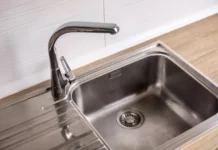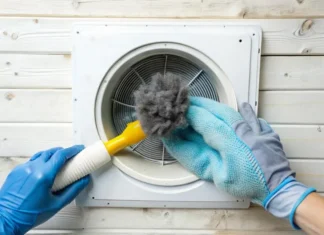The material of cookware plays a vital role when it comes to selecting cookware for your kitchen. With a wide range of cookware models from different materials, it can be a challenging task to select one.
Hard anodized aluminum and stainless steel are the two most famous types of cookware. Both can handle any ingredient, can heat up evenly and fast, and are durable.
So now the question is which type of cookware is better? What’s the difference? Let’s solve the hard anodized and stainless steel cookware puzzle and break the things down.
Comparison between Hard Anodized Vs Stainless Steel Cookware
Aluminum and stainless steel have been used for centuries for cooking purposes. However, aluminum has lost its worth because of health reasons.
Every cookware material has many positive and negative attributes which are very important for making a decision about choosing one of the best ones.
Let’s find out the better qualities and the differences between the two types of cookware before buying.
Stainless Steel Cookware
It is a popular finish material used for the manufacture of pans and pots. The material lasts for many years in a kitchen and is durable.
The only negative point of this cookware type is that it is not a good heat conductor. It has to be bonded to a heat conductor material like aluminum or copper for better performance.
It is an alloy of both Chromium and iron which makes it tolerant to corrosion and has a long life.
You can find various types of stainless steel cookware.
- Austenitic
- Duplex
- Ferritic
- Martensitic
- Precipitation Hardening
The Austenitic made cookware tends to be of premium quality. The cookware marked stainless steel 18/10 or 18/8 or 304 which shows the composition of chromium and stainless steel. The number 18 means the amount of chromium and the other number is for the amount of nickel.
Is Stainless Steel Safe?
Yes, apart from cast iron, stainless steel cookware is one of the safest cookware. The material is hard to allow chemicals to penetrate inside the food.
Unlike copper and aluminum, cooking with stainless steel cookware poses no health problems.
Important factors to consider when buying stainless steel cookware
- Ply cookware
- Heat conductivity
- Lids and handles
- Magnetic or non-magnetic
- Maintenance
- Price
- Durability – 18/10.
PROS & CONS
| Pros | Cons |
| Durable and tough, long-lasting | Lightweight, easy to move |
| Easy to maintain | Does not cook evenly |
| Time saver | Expensive |
| Completely safe | Not a good conductor of heat |
| Versatile | |
| Cost-effective | |
| Smooth and shiny, require less cleaning | |
| Attractive appearance | |
| Non-reactive to acid and basic food |

Hard Anodized Cookware
Aluminum is a good conductor of heat after copper. It is portable and lightweight which can be handled easily. Due to its availability around the world, the cost of aluminum is inexpensive.
The only drawback is it can react with some foods as aluminum is softer.
For this reason, the Calphalon company started the application of a nonstick layer on top of aluminum for the prevention of leaching to food.
Hard anodized aluminum cookware is manufactured using the process of electrochemical to change aluminum with a nonstick coating.
The aluminum is 30% harder as compared to stainless steel, making it durable, when aluminum is anodized.
After some years, the nonstick surface of the cookware gets damaged which leads to purchasing another cookware.
Is Hard Anodized Cookware Safe?
Since the anodization minimizes the reactiveness chances of the aluminum, the cookware is safe to use. The nonstick coating locks the aluminum perfectly according to the manufacturer and it is unable to react with the food.
Pros & Cons
| Pros | Cons |
| Low price | Manual washing |
| Easy to clean | Not compatible with induction cooktops |
| High cooking performance, even cooking | Not safe to use high heat |
| An excellent conductor of heat | Reactive to acid or basic food |
| Non-stick, non-toxic with less or no oil usage |
Difference between anodized aluminum vs stainless steel cookware
Aluminum cookware is great in heat conductivity even when anodized. The food is cooked evenly and faster.
Stainless is a bad conductor of heat resulting in white spots during cooking. Nowadays the conductivity of heat is solved by combining stainless steel with good conductors of heat like aluminum and copper.
It is better to check when buying stainless steel cookware, whether it’s a multi-clad of aluminum or copper.
Non-stick coating
Mostly, stainless steel cookware doesn’t possess a nonstick coating which causes stickiness of some food items.
Hard anodized cookware has nonstick layers which are resistant to sticking with easy repealing of food. Nonstick cooking uses a little amount of oil with promoting health practices.
Price
The prices are variable within the cookware models. The price of hard-anodized stainless steel cookware is dependent on the quality because of nickel and multi-ply used in manufacturing the cookware.
The high-end ones are pricey, but you can find inexpensive stainless steel.
Depending on the hard anodized cookware line, the price varies.
Durability
Both of the materials used for manufacturing the cookware are durable and strong. They can tolerate scratching and corrosion because of the extra hard surface.
As compared to stainless steel, hard anodized cookware is harder as the coating is like an extra coating. Though, with time the coating damages down with time, it works best during the estimated durable time.
Safety
As compared to hard-anodized, stainless steel is safer in regard to the toxicity of cookware from a health point of view.
With acidic food, aluminum is reactive and health issues can be caused by excessive consumption of aluminum.
The positive point is that layering the surface of aluminum with a non-stick coating minimizes the food-reacting risk with aluminum.
Maintenance
With both cookware having simple maintenance routines, maintaining cookware is not a hard task. The cleaning of stainless steel, for instance, is easy as it is dishwasher safe.
Hand washing requires a metal scrubber to remove the sticking food in the case of stainless steel cookware.
In contrast, hard anodized aluminum cookware has a nonstick layer that is easily cleaned. It is not dishwasher safe and requires a sponge cleaner, warm water, and dish soap to clean the cookware easily and safely.
The Bottom Line
So here’s the difference between hard anodized vs stainless steel cookware. Both cookware has a dream to provide the minor and major aspects of both these types. Both possess their own advantages and disadvantages which cancel out each other ultimately. Both cookware is different in their own way with the provision of better outcomes. They are strong, easy to use, and durable in various tasks.












